Cats are naturally drawn to plants for their textures and scents, or just out of curiosity 🐱🌿.
We’ll navigate through an array of cat-approved botanicals, pinpointing those that promise to be safe additions to your living space. As we traverse this verdant landscape, we’ll highlight the botanical varieties that promise to enrich your home’s ambiance while contributing to your cat’s sensory and emotional satisfaction. Embark on this journey with us to identify the perfect verdant companions for your curious feline.
Let’s explore the cat-friendly greens that can brighten up your home and improve your cat’s happiness 🏡😺🍃.
Catnip – A Feline Favorite
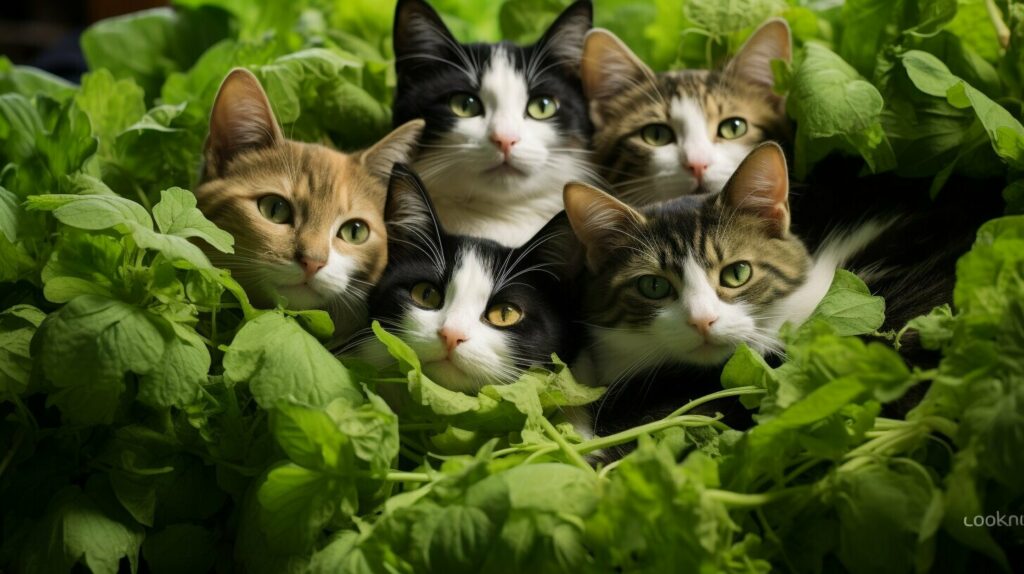
When it comes to plants that cats absolutely adore, catnip is at the top of the list. This member of the mint family has a mesmerizing effect on approximately 50% of cats, sending them into a state of playful bliss. Not only is catnip irresistible to our feline friends, but it’s also incredibly easy to grow, making it a must-have addition to any cat-friendly garden.
To cultivate catnip, simply find a sunny spot in your garden or a pot that allows for proper drainage. Sow the seeds, lightly cover them with soil, and keep the area consistently moist until germination occurs. Once the plants are established, they will flourish and provide endless entertainment for your cat.
Valerian – A Calming Stimulant
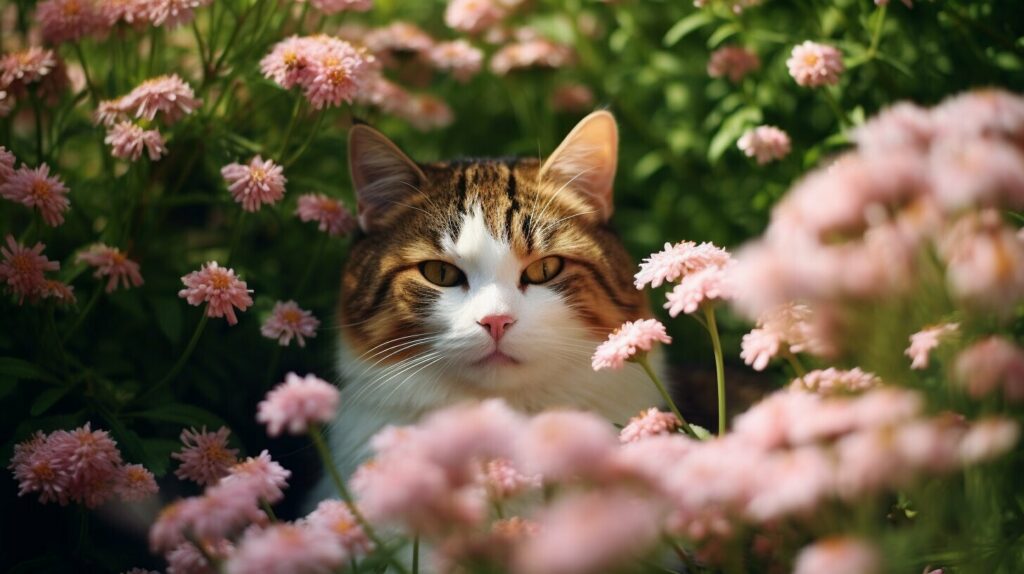
When it comes to stimulating plants for cats, valerian is a top choice. Similar to catnip, valerian has a calming effect on cats, making it particularly useful for nervous or stressed felines. While some may find the odor objectionable, valerian can be a great addition to your cat-friendly garden.
- Benefits of Valerian: Valerian is known for its calming properties and can help ease anxiety in cats. It can also provide a sense of comfort and relaxation, making it ideal for cats that struggle with stress-related behaviors.
- Using Valerian Safely: Valerian should be used in moderation and as directed. While it is generally safe for cats, it’s important to note that valerian can have a sedative effect, so it’s best to avoid using it before activities that require alertness.
- Valerian in Your Cat Garden: Consider incorporating valerian in your cat garden to provide a tranquil and stress-free space for your furry friend. Just make sure to plant it away from high-traffic areas and keep an eye on your cat’s reaction to ensure they are not overindulging.
Cat Thyme – A Surprising Feline Stimulant
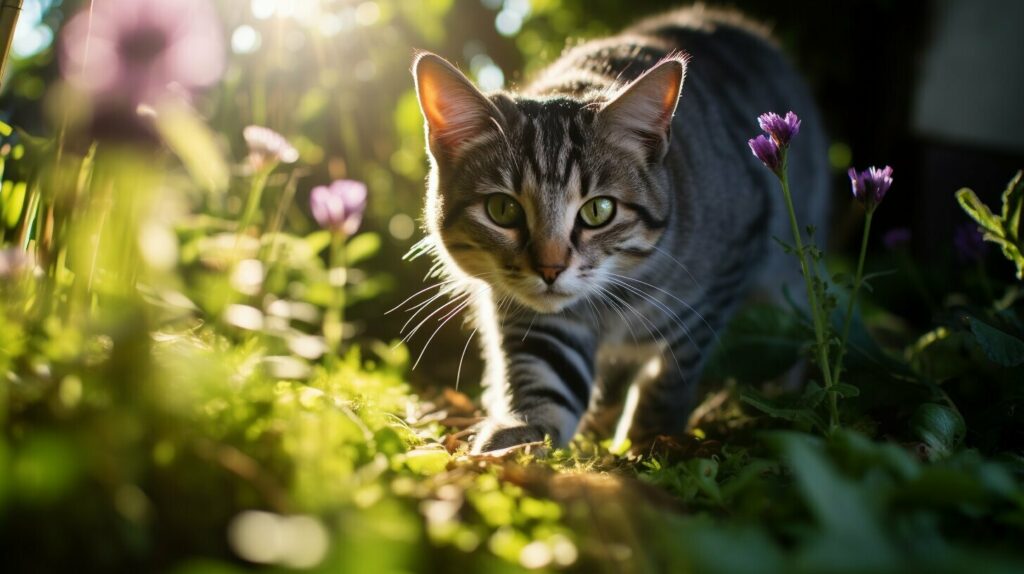
When it comes to stimulating plants for cats, cat thyme is a pleasant surprise. This slow-growing plant, with its small, strong-scented pink flowers, captivates felines and provides them with a delightful sensory experience. Cat thyme can be especially beneficial for cats that show no response to catnip, offering them a new and exciting source of stimulation.
Similar to catnip, cat thyme contains a compound called nepetalactone, which triggers a playful and euphoric response in many cats. This aromatic herb can be grown both indoors and outdoors, making it easily accessible for your furry friend. Place it in an area where your cat can brush against it or roll around in its enticing fragrance.
Why Cat Thyme Is a Great Choice:
- Acts as a stimulating alternative for cats unresponsive to catnip
- Offers a source of visual appeal with its vibrant flowers
- Provides a pleasant aromatic experience for both cats and their owners
- Contributes to a stimulating and engaging cat-friendly garden
Licorice Root – Health Benefits for Cats
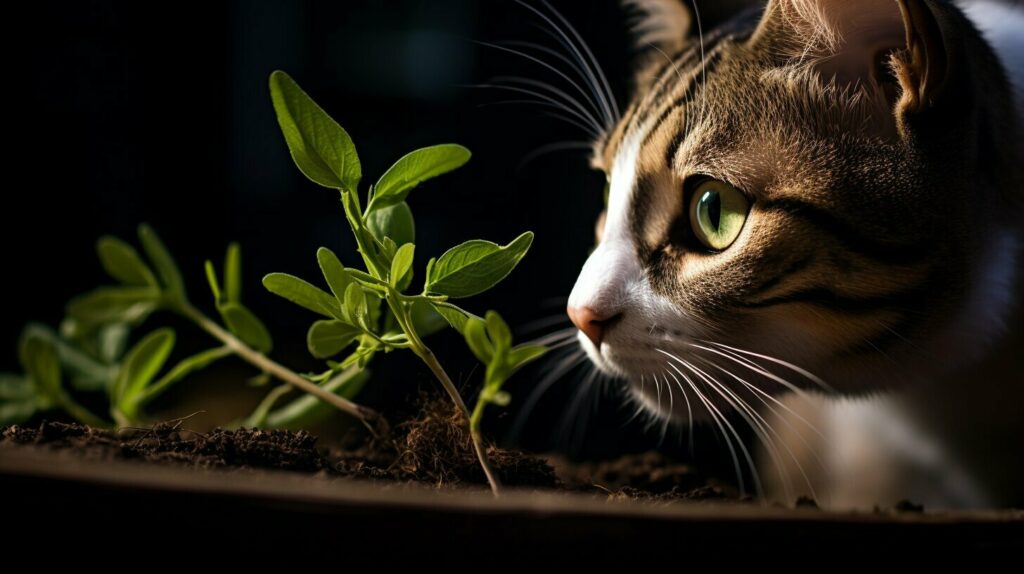
When it comes to promoting the well-being of our feline friends, licorice root is an incredible natural remedy. This medicinal plant offers numerous health benefits that can contribute to your cat’s overall health and happiness. From its anti-inflammatory properties to its soothing effects on arthritic conditions, licorice root is a valuable addition to your cat’s diet.
One of the key benefits of licorice root for cats is its ability to reduce inflammation in the body. This makes it particularly effective in alleviating symptoms of arthritis and other inflammatory conditions. By incorporating licorice root into your cat’s diet, you can help ease their discomfort and improve their mobility.
The health benefits of licorice root for cats:
- Anti-inflammatory properties
- Soothing effects on arthritic conditions
- Promotes liver health
- Aids in resolving digestive issues
Cat Grass – A Nutritious Treat
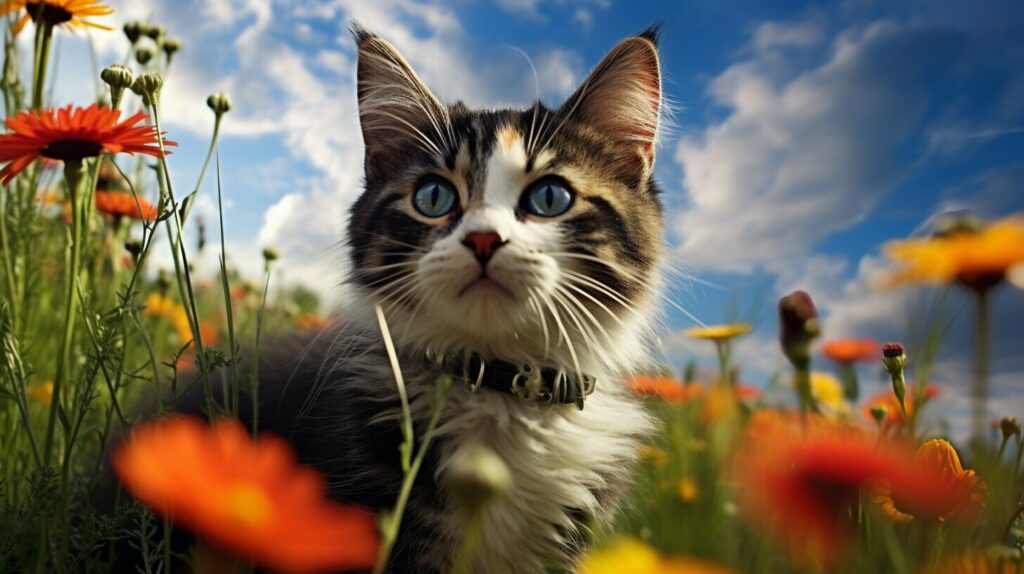
One of the most popular and healthy plants for cats is cat grass. Also known as wheat grass, oat grass, or barley grass, cat grass is a non-stimulant plant that naturally attracts cats. It provides essential nutrients that may be lacking in their regular diet, aids digestion, and helps resolve hairballs. Growing cat grass is an easy and attractive way to support your cat’s health and well-being.
The Benefits of Cat Grass for Cats
- 1. Nutrient-rich: Cat grass is rich in vitamins, minerals, and antioxidants that are beneficial for your cat’s overall health.
- 2. Digestive aid: Consuming cat grass helps cats to naturally eliminate hairballs from their digestive system.
- 3. Behavioral stimulation: Cats enjoy chewing and playing with cat grass, which provides mental and physical stimulation.
- 4. Safe alternative: Cat grass serves as a safe alternative to outdoor grass, which may be treated with harmful chemicals.
Lemongrass – A Mild Stimulant for Cats
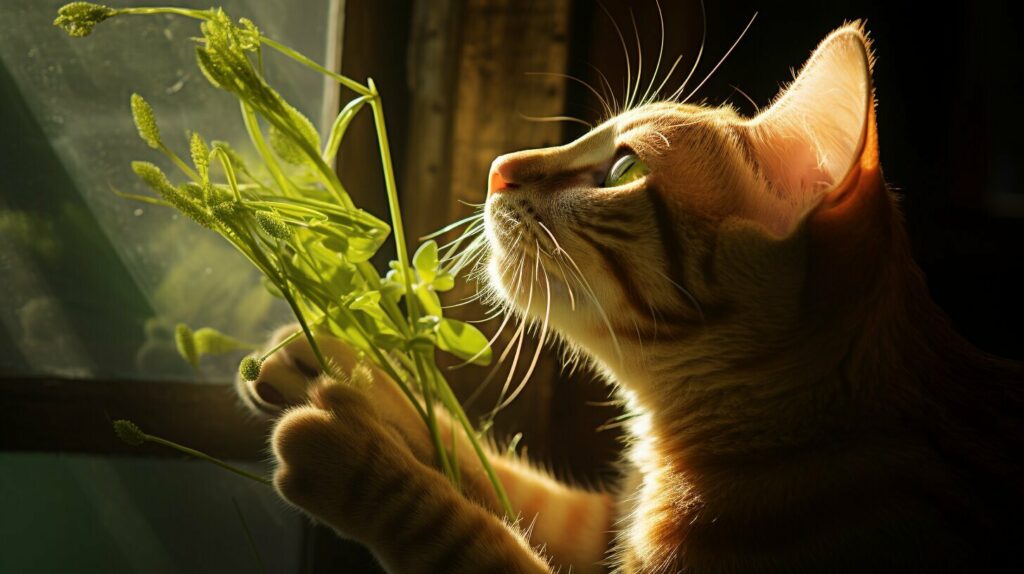
Lemongrass, with its refreshing aroma and vibrant green stalks, is not only a popular herb in cooking but also a safe and mild stimulant for cats. It offers similar benefits to other cat-friendly grasses and can be a great addition to your furry friend’s environment. Not only does lemongrass provide sensory stimulation, but it also adds visual appeal to your cat garden.
Adding lemongrass to your cat-friendly garden is a simple and enjoyable endeavor. The graceful stalks can be grown both indoors and outdoors, making it a versatile option. Whether you choose to plant it in a pot or directly in the ground, ensure that the soil is well-draining and that the plant receives adequate sunlight for healthy growth.
The Benefits of Lemongrass for Cats:
- Lemongrass provides a mild stimulant effect, offering cats a source of mental and physical enrichment.
- The refreshing aroma of lemongrass can help create a calming atmosphere for your feline friend.
- Visual appeal: The vibrant green stalks of lemongrass add beauty to your cat garden and create an inviting space for your cat to explore.
Mint – an Irresistible Aroma
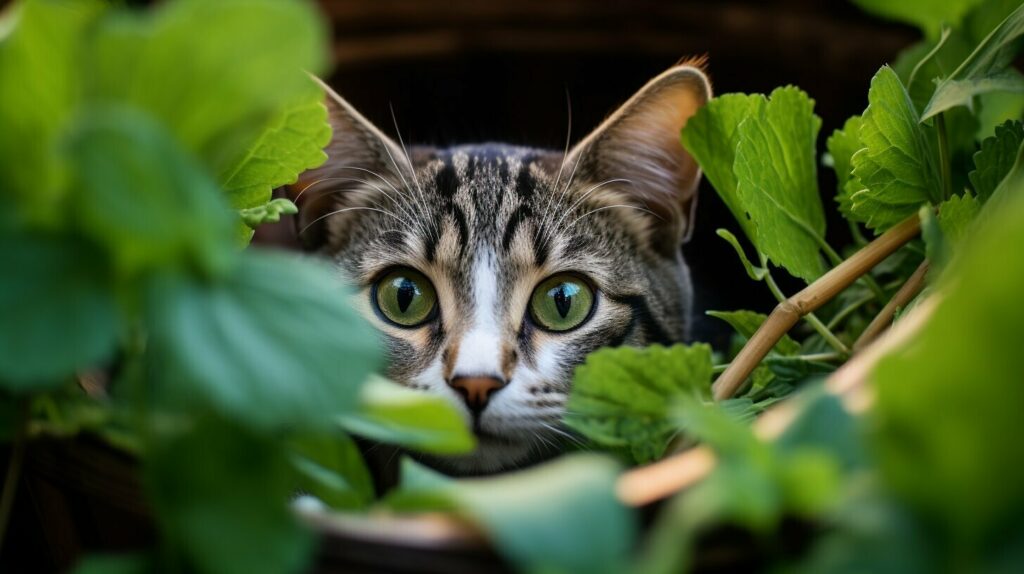
When it comes to cat-friendly plants, mint is a must-have in any feline garden. Not only does it add a refreshing touch to your outdoor space, but it also captivates cats with its irresistible aroma. Mint plants, which are easy to grow and prolific in their growth, provide a sensory experience for your furry friend. Cats are more likely to sniff and roll around in mint rather than eat it, making it a safe addition to your cat’s environment.
There are various types of mint plants that you can choose from, including spearmint, peppermint, and catmint. Each variety offers its unique scent and flavor, ensuring there’s something to suit every cat’s taste. However, it’s important to note that while mint is generally safe for cats, excessive consumption of peppermint may cause digestive upset. As with any plant, it’s essential to monitor your cat’s behavior and ensure they’re not overindulging.
Benefits of Mint for Cats:
- Mint plants provide a sensory experience for cats, attracting them with their irresistible aroma.
- Sniffing and rolling around in mint can provide mental stimulation and enrichment for your cat.
- Mint is generally safe for cats to interact with, making it a suitable addition to your cat-friendly garden.
Cat’s Claw
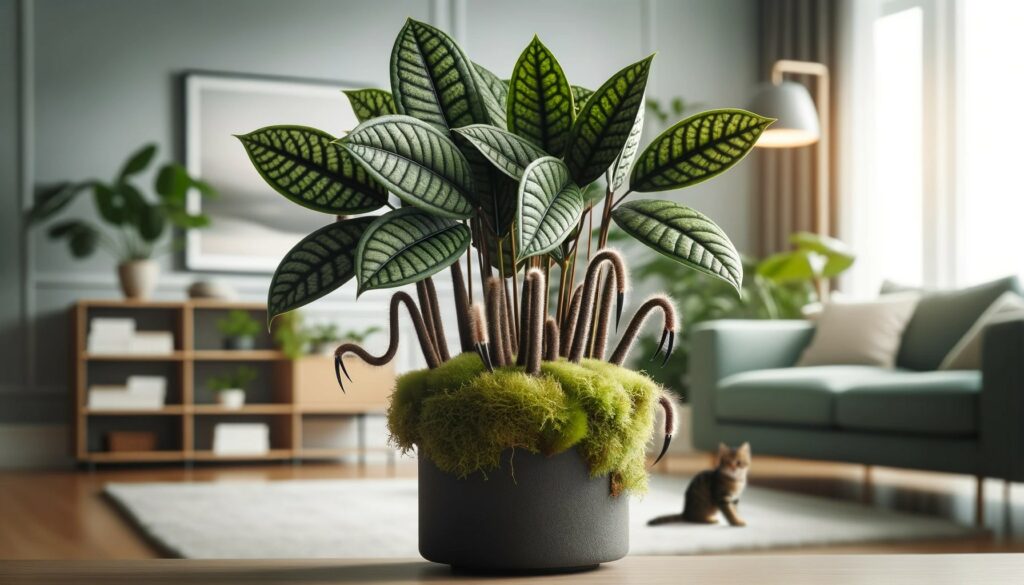
Cat’s claw, also known as Uncaria tomentosa, is a vine native to the Amazon rainforest. It has been a popular choice in traditional medicine for both humans and animals. This plant offers various health benefits, including immune system support and anti-inflammatory properties. Cat’s claw can be grown as a climbing plant in your cat garden, providing both visual interest and potential health benefits for your feline friend.
Goldenseal
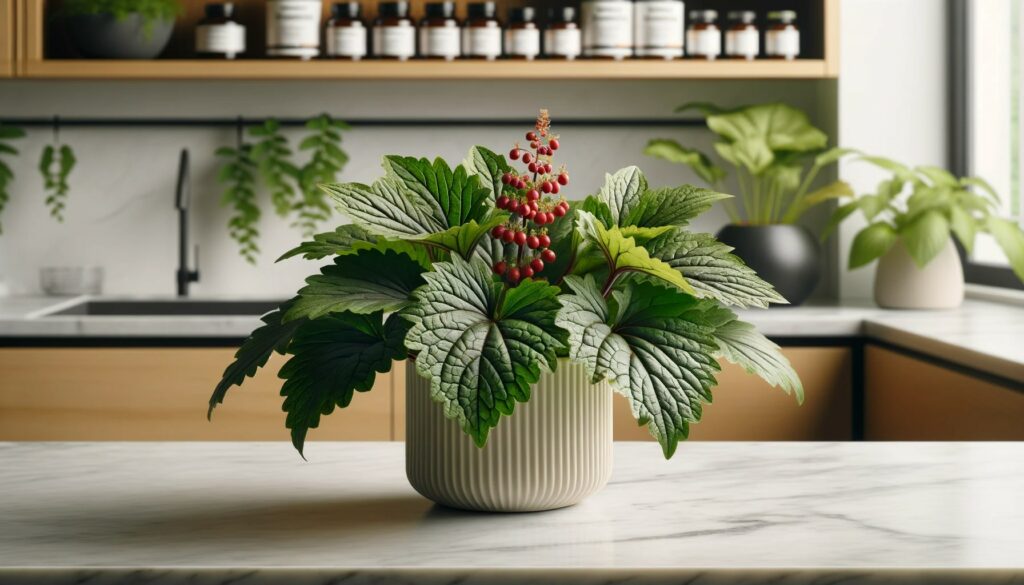
Goldenseal, scientifically known as Hydrastis canadensis, is a perennial herb native to North America. It is well-known for its medicinal properties, including its antibacterial and anti-inflammatory effects. While goldenseal is primarily used for humans, it can also be incorporated into your cat garden to add diversity and potential health benefits.
Chamomile
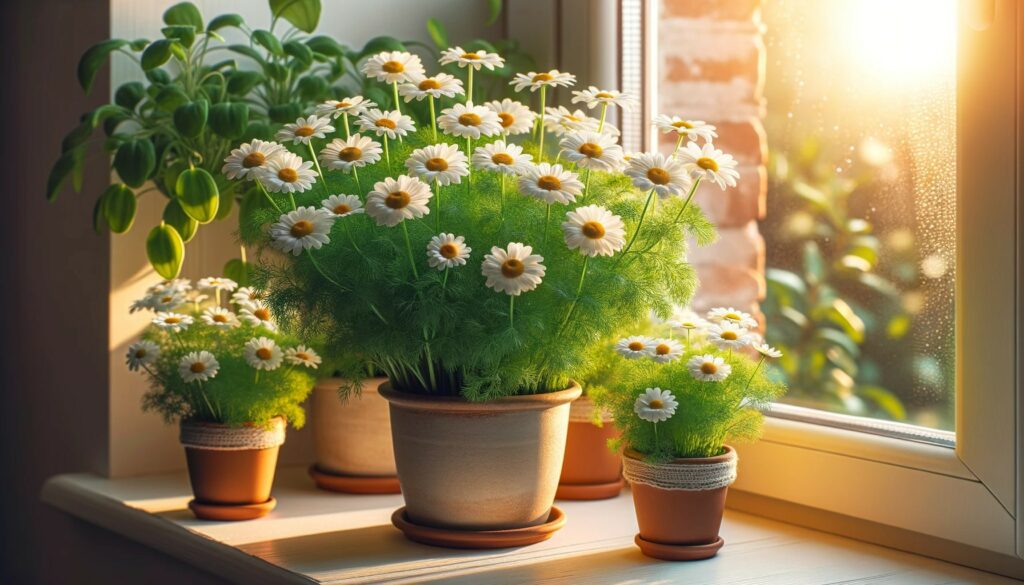
Chamomile is a gentle and soothing herb that can promote relaxation and calmness in cats. It has anti-inflammatory properties and can help relieve digestive issues. Whether grown as a low-lying plant or as a part of a larger garden, chamomile provides a safe and enjoyable option for your cat-friendly space.
Incorporating a variety of plants into your cat garden not only enriches your cat’s environment but also adds beauty and interest to your space. Consider these cat-friendly options and create a feline garden that will delight both you and your furry companion.
Creating a Cat Garden at Home
Creating a cat garden at home is a wonderful way to provide your beloved feline with a safe and enriching outdoor environment. By designing a space catered specifically to their needs, you can enhance their overall well-being and give them a place to explore, play, and relax.
To start creating your cat garden, consider incorporating a variety of cat-friendly plants that offer sensory stimulation. You can include catnip, valerian, cat thyme, and other stimulating plants to engage your cat’s senses and create a space they’ll love. Additionally, consider adding cat grass, which aids in digestion and provides essential nutrients for your cat.
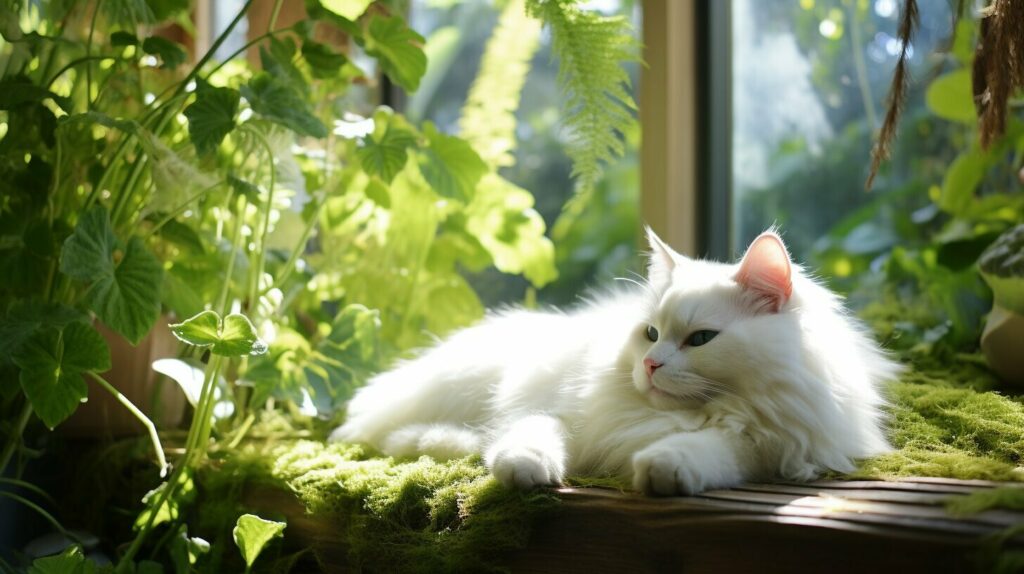
When planning your cat garden, think about providing different areas for your cat to enjoy. You can include climbing structures, scratching posts, and cozy hiding spots to cater to their natural instincts. By offering a variety of textures and surfaces, you’ll keep your cat entertained and satisfied.
Considerations for a Cat Garden:
- Safety: Ensure that all plants and materials used in your cat garden are non-toxic and safe for cats to interact with.
- Accessibility: Create pathways and open spaces for your cat to navigate easily. Cats love to explore and jump, so incorporate levels and platforms for them to climb on.
- Shade: Provide shaded areas in your cat garden to protect your furry friend from the sun’s harsh rays.
- Water source: Consider placing a small water feature, such as a shallow fountain or bowl, for your cat to drink from.
By following these guidelines and tailoring your cat garden to your feline friend’s preferences, you’ll create a paradise that both you and your cat can enjoy. Spend quality time together in your outdoor space, observe their curiosity and happiness, and cherish the moments you share in your very own cat garden.
Tips for Growing Cat-Friendly Plants from Seed
Starting a cat garden from scratch can be an exciting and rewarding endeavor. One of the most cost-effective ways to begin is by growing plants from seed. Not only does this allow you to have a wider variety of plants, but it also ensures that the plants are free from harmful chemicals. Here are some tips to help you successfully grow cat-friendly plants from seed:
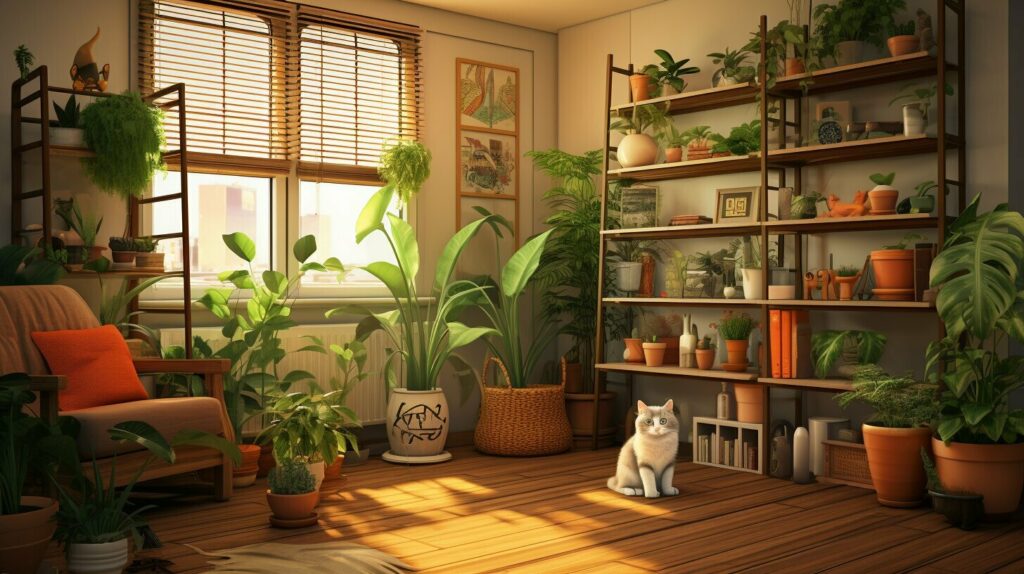
- Choose the right seeds: Select seeds of cat-friendly plants that are safe for your feline friend to interact with. Some popular choices include catnip, cat grass, and mint. Make sure to research the specific needs and growing conditions for each plant before purchasing the seeds.
- Prepare the soil: Use a well-draining soil mixture that is rich in organic matter. This will provide the necessary nutrients for the seeds to germinate and grow. It’s also important to ensure that the soil is free from any potential contaminants.
- Sow the seeds: Follow the instructions on the seed packet for the optimal planting depth and spacing. Generally, seeds should be planted at a depth of two to three times their diameter. Gently press the seeds into the soil and water thoroughly.
- Provide the right conditions: Place the seed trays or pots in a warm and well-lit area, such as a sunny windowsill or a greenhouse. Make sure to maintain consistent moisture levels by watering regularly, but be careful not to overwater as this can lead to rotting.
- Monitor and care for the seedlings: Keep a close eye on the progress of the seedlings as they grow. Thin them out if they become overcrowded to allow for proper growth. Once the seedlings have developed a few sets of true leaves, they can be transplanted into larger pots or directly into your cat garden.
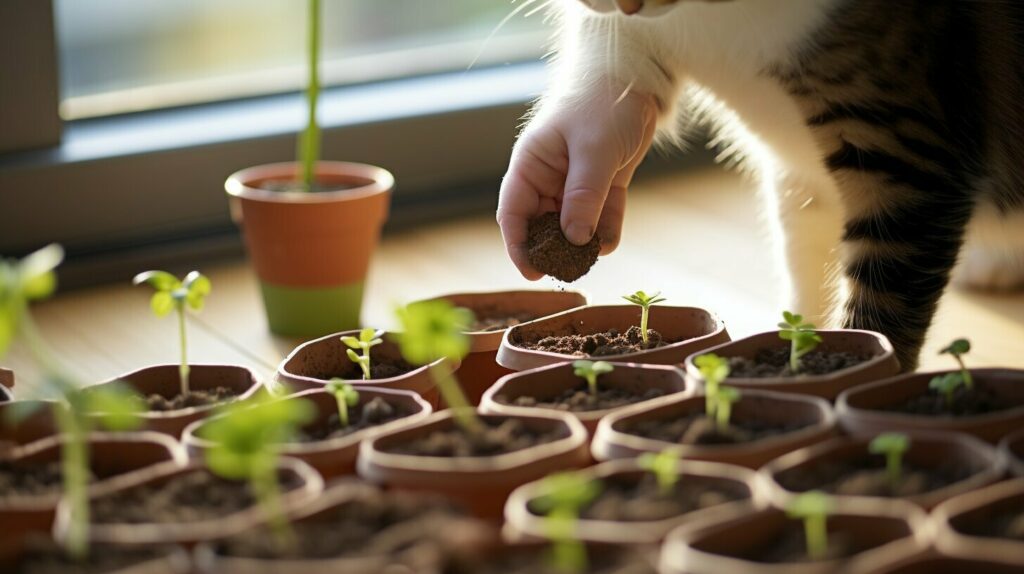
Additional Tips for Success
- Label your seeds: It’s easy to forget which seeds you planted where, so labeling each tray or pot will help you keep track of your plants.
- Start seeds indoors: If you’re starting your cat garden from scratch, it’s best to start the seeds indoors to ensure optimal conditions for germination. Once the seedlings are strong enough, you can gradually acclimate them to outdoor conditions.
- Provide support for climbing plants: If you’re growing climbing plants such as catnip or cat thyme, consider providing a trellis or other support structure for them to grow on. This will help prevent them from sprawling and keep your garden neat and tidy.
Choosing Safe and Poisonous Plants for Cats
When creating a cat-friendly garden, it is essential to prioritize the safety of our feline friends. While there are numerous plants that cats love to have around, it’s important to be aware of those that can be toxic to them. Here is a list of plants to avoid:
- Oleander: This flowering shrub is highly toxic to cats and can cause severe gastrointestinal issues, cardiac problems, and even death if ingested.
- Poinsettias: While poinsettias are not as poisonous as once believed, they can still cause mild gastrointestinal discomfort if consumed by cats.
- Yew: All parts of the yew plant, including the berries, are toxic to cats and can lead to serious health issues, including cardiac arrest.
- Lily of the valley: This delicate plant contains cardiac glycosides that can cause cardiac arrhythmias and other severe symptoms if ingested by cats.
- Azaleas and rhododendrons: These flowering shrubs contain toxins that can cause vomiting, diarrhea, and even cardiovascular collapse in cats.
Disclaimer: Research and identify any plants in your garden or home that may pose a threat to your cat’s health. If you suspect your cat has ingested a toxic plant, contact your veterinarian immediately. Creating a safe and enjoyable environment for your cat is crucial, and by avoiding poisonous plants, you can maintain their well-being.
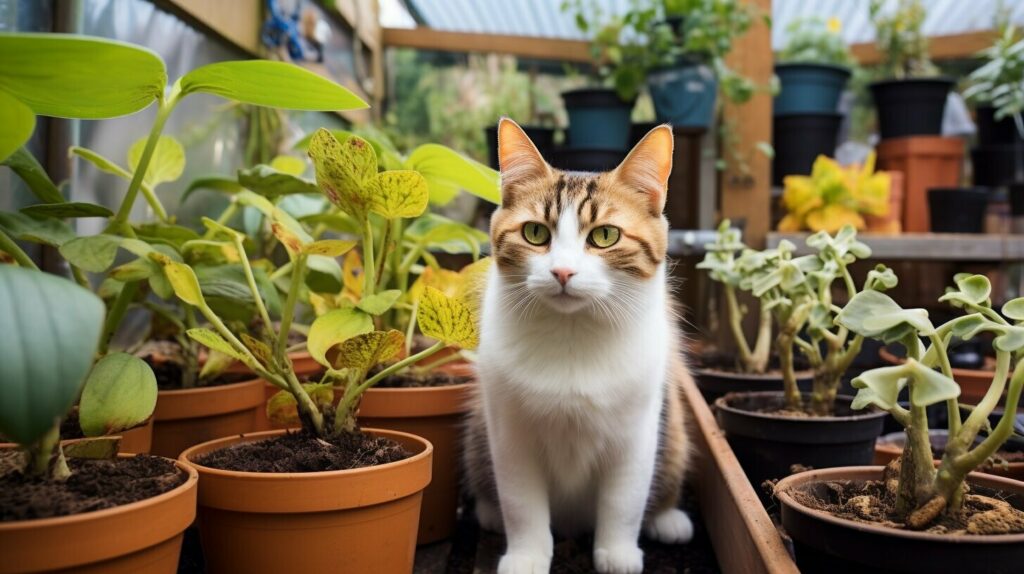
Ensuring a Cat-Safe Environment
In addition to being mindful of toxic plants, there are other steps you can take to ensure a cat-safe environment:
- Secure all potential hazards like open water sources, electrical cords, or toxic chemicals in the garden.
- Opt for organic and natural pest control methods to avoid exposing your cat to harmful chemicals.
- Create designated play and relaxation areas for your cat, providing them with their own space to enjoy.
- Regularly inspect your cat’s toys and accessories for any potential dangers, such as loose strings or small parts that could be swallowed.
Care and Maintenance of a Cat Garden
Once you have set up your cat garden, it’s important to provide proper care and maintenance to ensure the health and vitality of your cat-friendly plants. Here are some tips to help you keep your cat garden thriving:
- Watering: Regularly water your plants to keep the soil moist but not overly saturated. Be mindful of the specific water needs of each plant in your garden.
- Fertilizing: Use organic fertilizers to nourish your plants and promote healthy growth. Avoid using chemical-based fertilizers that could be harmful to your cat if ingested.
- Pest Control: Monitor your cat garden regularly for any signs of pests. If necessary, use natural pest control methods that are safe for both your plants and your cat.
- Pruning: Trim any dead or damaged leaves from your plants to maintain their overall health and appearance. Pruning also helps stimulate new growth.
Creating a Safe Environment for Your Cat Garden
In addition to caring for your plants, it is essential to create a safe environment for your cat in the garden. Here are some measures you can take:
- Avoid Toxic Plants: Make sure to research and identify any plants that may be toxic to cats. Remove them from your garden or keep them out of your cat’s reach.
- Secure Boundaries: Create boundaries, such as fences or garden nets, to prevent your cat from wandering off or encountering potential dangers outside of the garden area.
- Provide Shade and Shelter: Ensure that your cat has access to shaded areas and shelter from the elements, especially during hot or inclement weather.
- Eliminate Harmful Chemicals: Avoid using pesticides, herbicides, or fertilizers that could be toxic to your cat. Opt for natural alternatives instead.
Enjoying the Rewards of Your Cat Garden
Maintaining a cat garden requires dedication and attention, but the rewards are well worth it. Not only will your cat have a stimulating and enriching space to explore, but you will also have a beautiful and vibrant garden to enjoy. Take pride in the care and effort you put into your cat garden, and watch as it becomes a haven of joy, relaxation, and health for both you and your feline friend.
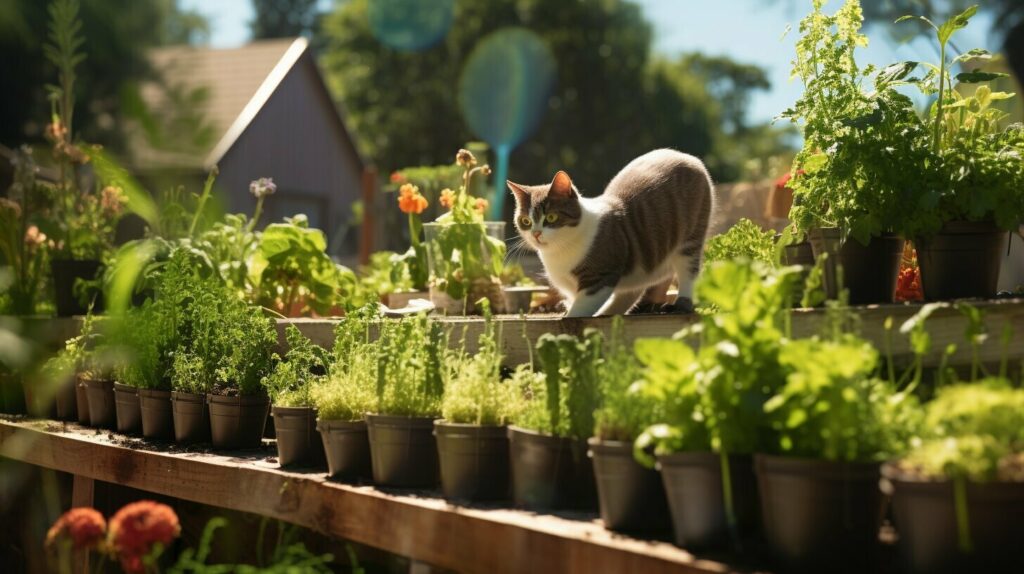
Enhancing the Cat Garden Experience
Creating a cat-friendly garden is not just about selecting the right plants; it’s also about creating an enriching environment for your feline friend. By incorporating cat-friendly garden accessories and decor, you can elevate your cat garden to a whole new level of enjoyment and sensory stimulation for your furry companion.
1. Cat Climbing Structures:
- Provide vertical space for your cat to explore and play
- Choose sturdy structures with platforms, perches, and scratching surfaces
- Place them strategically around your cat garden to encourage exploration
2. Cat-friendly Mobiles:
- Hang mobiles with dangling toys or feathers to engage your cat’s natural hunting instincts
- Opt for interactive mobiles that allow your cat to bat and swat at the objects
- Ensure the mobiles are securely attached to prevent accidents
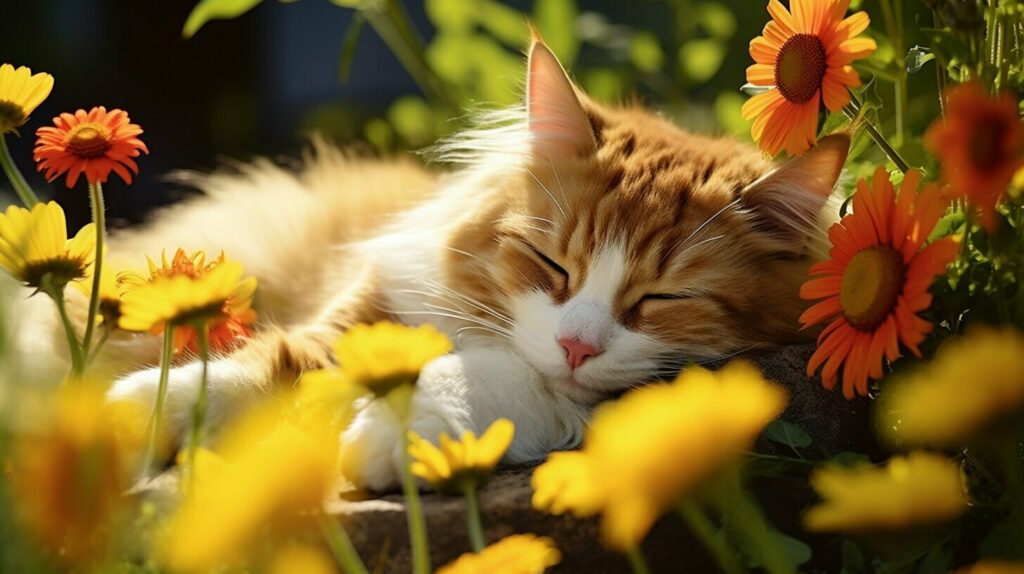
3. Wicker Containers:
- Provide cozy, comfortable spaces for your cat to nap and relax
- Choose wicker containers with soft cushions or blankets
- Position them in shaded areas of your cat garden for peaceful lounging
4. Scratch Posts and Pads:
- Offer designated areas for your cat to scratch and groom
- Choose scratch posts or pads made of sisal or other cat-friendly materials
- Place them near plants to redirect your cat’s scratching behavior
FAQ
Are all the plants mentioned safe for cats?
Yes, all the plants mentioned in this article are safe for cats when consumed in moderation. However, it’s important to avoid plants that are toxic to cats.
Can I grow catnip indoors?
Absolutely! Catnip can be easily grown indoors in pots or containers. Just make sure to place it out of your cat’s reach to avoid overconsumption.
How often should I give my cat catnip as a treat?
It’s recommended to give catnip as an occasional treat rather than on a daily basis. This will help maintain its effectiveness and prevent your cat from becoming desensitized.
What are some other stimulating plants for cats?
In addition to catnip, valerian and cat thyme are great options. These plants can provide a similar stimulating effect and can be enjoyed by cats that do not respond to catnip.
Is lemon grass safe for cats?
Yes, lemongrass is safe for cats and can be a mild stimulant. It is often enjoyed for its appealing aroma and can be grown both indoors and outdoors.
Can cats eat mint leaves?
Cats are more likely to sniff and roll around in mint rather than eat it. However, consuming large amounts of peppermint may cause digestive upset in cats, so it’s best to monitor their intake.
Can I mix different cat-friendly plants in the same garden?
Absolutely! Mixing different cat-friendly plants in the same garden can create a diverse and stimulating environment for your cat. Just make sure to research the specific care requirements of each plant.
How do I create a cat garden at home?
Creating a cat garden at home involves selecting cat-friendly plants, ensuring their safety, and creating an inviting environment. We provide a detailed guide in this article on how to create your own cat garden.
What are some important considerations when starting a cat garden from seed?
When starting a cat garden from seed, it’s important to choose the right soil mixture, water properly, and provide the right germination conditions. We provide tips and guidance in this article for successful seed germination.
Are there any plants I should avoid if I have a cat?
Yes, there are several plants that can be toxic to cats and should be avoided. Some examples include oleander, poinsettias, yew, and lily of the valley. We provide a comprehensive list in this article.
How should I care for my cat garden?
Proper care and maintenance are essential for the well-being of your plants and your cat’s enjoyment. We provide tips on watering, fertilizing, pest control, and ongoing plant care in this article.
What are some accessories that can enhance my cat garden?
There are various accessories and additions that can be incorporated into your cat garden, such as climbing structures, scratching posts, wicker containers for napping, and interactive mobiles for play. We explore these options in this article.
What are the benefits of having a cat garden?
A cat garden provides your feline friend with a safe and stimulating outdoor experience. It offers sensory stimulation, relaxation, and health benefits for your cat, while also enhancing the overall aesthetic of your home. We discuss the benefits of a cat garden in this article.





